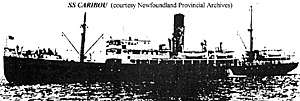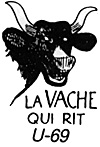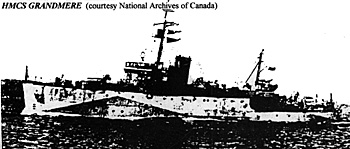
“When Hitler marched into Poland in 1939, a chain of events was set in motion that would forever change the history of the little island of Newfoundland in the North Atlantic. In the early stages of the Second World War, the Atlantic Ocean became a battleground, as German U-Boats attempted to disrupt the shipping lanes connecting Europe with North America.
SS CARIBOU (courtesy Newfoundland Provincial Archives)
Being an island herself, Great Britain depended heavily on supplies brought by ship. The German High Command believed that if this supply line could be cut, Great Britain would be forced into submission. the strategy nearly paid off in the First World War. Only with the development of the convoy system did the tide swing against the Kaiser’s subs.
The early years of World War II brought much success to the German U-Boat Arm. Recognizing the need for more anti-submarine defenses, the British Prime Minister, Winston Churchill, worked out a deal with the United Stated Government. In exchange for 50 old four-stack American destroyers, the British Government would grant the U.S. access to British territory for the establishment of military bases. As a result of this arrangement, Newfoundland was promptly ‘invaded’ by the U. S. Military.
The role of Newfoundland during the Second World War was two-fold. Being a loyal colony of Great Britain, thousands of Newfoundlanders patriotically enlisted in the British Navy and merchant marine. By War’s end, over 1,000 had paid the supreme sacrifice in defending the mother country.
The geography of Newfoundland was also to play a vital role in the War. With the Battle of the Atlantic raging all around, the strategic importance of the island was quickly recognized. When the United States entered the War in 1941, there followed a massive military build-up in Newfoundland. Such towns as Gander, Stephenville, Goose Bay & Argentia were transformed by the U.S. into large bases, fully equipped to engage the U-Boat threat. To this day, the bases at Goose Bay and Argentia are still in operation as part of NATO, although in a much reduced role. The U.S. Navy base at Argentia is to be phased out within the next two years.
AIRCRAFT CARRIER NEWFOUNDLAND
The location of Newfoundland made it an ideal location for anti U-Boat operations. In fact, the island was to function as a giant aircraft carrier during the hostilities. Argentia and St. Johns were the two escort bases during the War. Destroyers and smaller corvettes used both as supply centers before accompanying their charges across the ocean. With the development of anti-submarine aircraft, airstrips were built at St. Johns, Gander, Goose Bay and Stephenville. CATALINAS and other aircraft were stationed there by the hundreds. As a side note - many of the CATALINAS used during the War for combating U-Boats have a new mission as part of the Newfoundland Government’s water bomber fleet - more than fifty years after their construction!
With merchant ship losses reaching staggering levels, the convoy system was reintroduced in an attempt to combat the marauding U-Boats. The two North American centers for convoy formation were Halifax (Nova Scotia) & St. Johns (Newfoundland). From these two locations, the convoys with their escorts, would set out on the long journey across the Atlantic. Many never made it. Few merchant ships stood little chance of remaining afloat after being hit by a torpedo. It was such an act that would lead to Newfoundland’s greatest marine tragedy during the war.
BIRTH OF A CARIBOU
The CARIBOU was built in Rotterdam, Holland during the ‘Roaring Twenties’. She was launched on 5 June 1925 and arrived in St. Johns on 25 October of the same year. Measuring 267 feet overall and weighing 2,200 tons (GRT) the CARIBOU was the largest and most luxurious vessel that the Newfoundland-Nova Scotia service had seen. While not in the same league as the great trans-Atlantic liners, the ship nevertheless was the pride of the Newfoundland fleet. With her 3,000 hp engines and steel reinforced bow, the CARIBOU was ideally suited for the winter conditions experienced in the Gulf of St. Lawrence.
The route the CARIBOU called her home was the ‘Gulf’, the 96 miles separating Port aux Basques, Newfoundland and North Sydney, Nova Scotia. The ‘Gulf’ could be considered a miniature Atlantic Ocean. Being an island, Newfoundland’s survival depended on supplied being brought in by ship. In turn, exports such as fish and wood were transported to Canada and the rest of North America. Up until 1949, Newfoundland was not part of Canada but a colony of Great Britain, and the island would play a major role in the two World Wars.
With a top speed of 14.5 knots, the crossing could be made in eight hours. Between 1925 and 1942, the CARIBOU made 3,600 of these tri-weekly trips. Being a new ship and one of the most reliable, the CARIBOU quickly became the most popular in the Newfoundland fleet. As there were few passenger planes in Newfoundland during the twenties and early thirties, the ship rarely sailed without a full passenger load.
DEATH OF A CARIBOU
 At seven o’clock on the evening of 13 October 1942, the SS CARIBOU departed Sydney, Nova Scotia on her regular night crossing to Port aux Basques, Newfoundland. The evening was dark, as there was no moon, and seas were calm. On board were 73 civilian passengers, 118 servicemen, and 46 crewmembers for a total of 237 souls. Even though the naval authorities were aware of U-Boat activity in the area, the crossing went ahead as planned. The CARIBOU was accompanied by HMCS GRANDMERE, a BANGOR Class minesweeper and escort vessel. the voyage across the ‘Gulf’ was uneventful, until about 40 miles outside of Port aux Basques. It was here that Captain Ulrich Gräf & the crew of U-69 were to meet Captain Ben Taverner and the CARIBOU.
At seven o’clock on the evening of 13 October 1942, the SS CARIBOU departed Sydney, Nova Scotia on her regular night crossing to Port aux Basques, Newfoundland. The evening was dark, as there was no moon, and seas were calm. On board were 73 civilian passengers, 118 servicemen, and 46 crewmembers for a total of 237 souls. Even though the naval authorities were aware of U-Boat activity in the area, the crossing went ahead as planned. The CARIBOU was accompanied by HMCS GRANDMERE, a BANGOR Class minesweeper and escort vessel. the voyage across the ‘Gulf’ was uneventful, until about 40 miles outside of Port aux Basques. It was here that Captain Ulrich Gräf & the crew of U-69 were to meet Captain Ben Taverner and the CARIBOU.
The submarine that was to shatter the stillness of the calm October night was built in Kiel, Germany. A TYPE VII-C boat, she measured 220 feet long and weighed 769 tons. 26 year old Captain Gräf joined the Navy as an enlisted man, but within a year he had risen to the rank of Midshipman and by 1939 was serving aboard a cruiser in the German surface navy. In November of 1940 Gräf began training for U-Boats and by April of 1941, he was First Officer on board U-74. From 1 October 1941 to 26 March 1942,
Gräf was in command of U-23. Shortly thereafter, he was given command of U-69. In May of 1942, the U-69 with Gräf as C.O., sank three ships in the Atlantic. By October of 1942, the submarine was operating in the Gulf of St. Lawrence. On 9 October, she torpedoed SS CAROLUS, a small British steamer. Not finding any other targets, the U-Boat was on her way out to sea when she just happened on the gulf ferry.
THE SHATTERING OF SILENCE
At a range of 700 meters, Captain Gräf ordered Torpedo Officer, Oberleutnant Hagemann, to fire one torpedo. 43 seconds later, the stillness of the night was once again interrupted by the death cries of a dying ship. the torpedo hit the CARIBOU on the starboard side, destroying two lifeboats and both wireless sets. Within five minutes, the pride of the Newfoundland gulf fleet was headed to the bottom of the Atlantic. As Gräf made his attack on the surface, his location was quickly discovered by the escorting GRANDMERE.
On that fateful night, Lieutenant James Cuthbert, Royal Canadian Reserve, was Commanding Officer on the GRANDMERE. As soon as CARIBOU was hit, GRANDMERE increased speed and headed toward the surfaced U-Boat in an attempt to ram. Losing the race, the GRANDMERE dropped a series of depth charges.
From the conning tower, Captain Gräf spotted the onrushing escort ship. Thinking that GRANDMERE was a destroyer, he ordered the U-Boat crash-dived. If he had recognized the ship for what she truly was, a small minesweeper, he probably would have remained on the surface. Not only would the U-Boat have been able to outrun GRANDMERE, but in a surface gun dual, the odds were pretty even. Yet all this is in retrospect, and Captain Gräf made the correct decision, given the available evidence.
 HMCS GRANDMERE (courtesy National Archives of Canada)
HMCS GRANDMERE (courtesy National Archives of Canada)
As U-69 passed under the port side of GRANDMERE, the escort dropped six depth charges. Two more passes were made, with an additional six charges dropped. None of the charges did any damage to the submerged U-Boat and after hours of searching, the GRANDMERE headed to the position of the CARIBOU’s sinking and began to pick up survivors.
As the ship sank in such a short period of time, panic and confusion by the passengers thwarted the rescue efforts by the crew members. Lifeboats were swamped, capsized and overturned. Those that survived the explosion quickly died of hypothermia in the icy cold water. In all, 137 people lost their lives in the disaster. There were only 100 survivors. Included in the loss were 31 of the 46 crew members. Captain Taverner and his two officers, Stanley and Harold were lost.
After escaping the GRANDMERE’s assault, U-69 headed out into the Atlantic after firing its last torpedo at a ship off St. John’s. The torpedo made a direct hit but as was often the case, failed to explode. After rendezvousing with a supply submarine (known as a ‘MILK COW’), the sub headed across the Atlantic, arriving at her French base on 5 November.
HARRY’S NOTE - The lucky ship that was hit with the dud torpedo was the 7,800 ton American steamer ROSA CASTLE. She was attacked at four minutes before 1 in the morning (German time) in grid square BB 6730.
After spending Christmas at home, Gräf and his crew departed on 1 February 1943 for the tenth mission of U-69. On 17 February, U-69 was sunk with all hands lost, by the Royal Navy destroyer HMS VISCOUNT.
HMCS GRANDMERE continued escort duties throughout the War. At the end of hostilities, like so many ships, she was declared surplus and was turned over to the Government’s War Assets Corporation. By 1951, she was under British registry out of Nassau in the Bahamas. It is believed that the ship ended her days as the JACK’S BAY, sailing between Cuba and Florida.
Just as with the sinking of the LUSITANIA in 1915 the cry ‘Remember the CARIBOU’ became the official Newfoundland slogan for war bonds and recruitment. It should be pointed out that the CARIBOU was a legitimate War target. She was listed at the time in Jane’s Fighting Ships as a reserve troop transport. Though tragic in nature, Captain Gräf was only doing what a good U-Boat commander was supposed to - sink enemy ships.
POSTSCRIPT
In remembrance of the CARIBOU, Marine Atlantic christened their newest Gulf ferry the CARIBOU in 1986. Together with her sistership, the JOSEPH & CLARA SMALLWOOD, both vessels are among the largest ice breaking ferries in the world. Displacing 26,000 tons and measuring 585 feet in length, each can accommodate 350 cars and 1,200 passengers.
In the early morning of 13 May 1986, the CARIBOU, second ship to bear the name, stopped its engines over the spot where the ship’s namesake had sunk 44 years before. On board were 14 survivors of the disaster. In honour of those who had died, a number of wreaths were dropped overboard and a moment’s silence held. It was a very emotional event for all on board.
GERARD, many thanks for this fine piece of writing and we are looking forward to your other two.
Back to KTB #123 Table of Contents
Back to KTB List of Issues
Back to MagWeb Master Magazine List
© Copyright 1996 by Harry Cooper, Sharkhunters International, Inc.
This article appears in MagWeb (Magazine Web) on the Internet World Wide Web. Other military history articles articles are available at http://www.magweb.com
Join Sharkhunters International, Inc.: PO Box 1539, Hernando, FL 34442, ph: 352-637-2917, fax: 352-637-6289, www.sharkhunters.com
